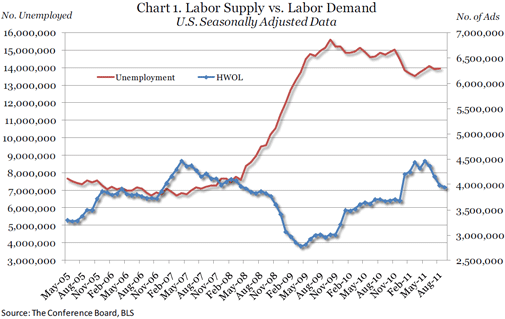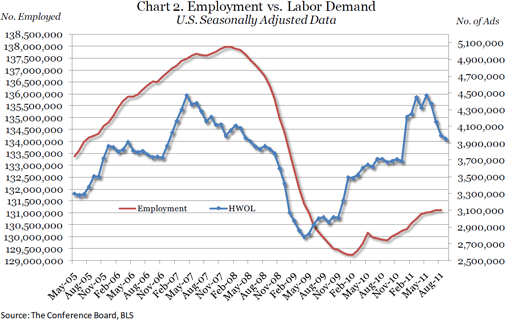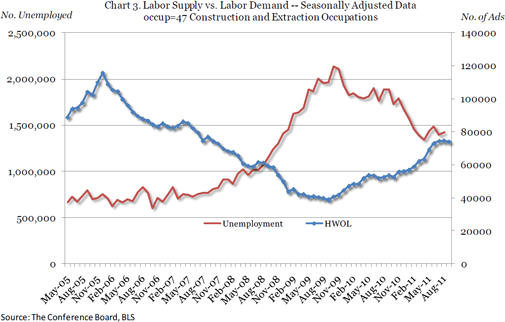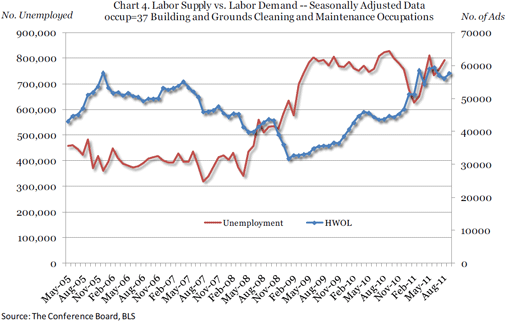Since March, labor demand down by 500,000 (11 percent)
Losses widespread across States and occupations
Nationally, there are 10 million more unemployed (9.98 million) than advertised vacancies
“In the last six months, labor demand has experienced a drop of 500,000, cutting sharply into the gain of 763,000 at the beginning of the year,” said June Shelp, Vice President at The Conference Board. “This narrows the average monthly gain for 2011 to 29,000.” The slowdown, however, varies widely for different occupations. In legal occupations, labor demand stalled as early as the beginning of 2010, but in the last six months it has dropped 23 percent to 21,600 in September. In contrast, advertised vacancies for production workers gained steadily since mid-2009 until July 2011, but in the last two months, it dipped further. It is now down 10 percent to 117,000 in September. (See occupational detail section.)


REGIONAL AND STATE HIGHLIGHTS
In September:
Like the U.S., many States now have flat or downward trends
The South and Midwest post modest gains while Northeast and West decline
In September, the Northeast posted a decline of 29,100, reflecting drops in all of its large States. Pennsylvania experienced the largest drop, 18,500, cancelling earlier gains in July and August. Massachusetts dropped 3,200, New Jersey fell 3,100, and New York lost 2,700. Among the smaller States in the region, New Hampshire and Connecticut dropped by small margins, 300 and 200 respectively, while Vermont and Rhode Island gained 500 and 100 respectively.
Labor demand in the West was down 18,400 in September and was led by the region’s largest State, California, which declined 16,800 to a total of 423,600. Washington State lost 5,100. Colorado rose 1,100, and Arizona gained a mere 300. Among the small States in the West, New Mexico gained 1,200, Utah gained 600, Idaho rose 500, and Nevada lost 1,000.
The South posted a gain of 8,900, reflecting slight gains in four out of six of its large States in September. Florida experienced the largest gain, 1,400. Next was Texas with a gain of 1,200. Maryland rose 400, and North Carolina gained 200. The region’s large States posting declines were Virginia, down 2,600 to 128,100, and Georgia, down 1,500 to 100,100. Among the smaller States in the South, Alabama gained 1,900, Oklahoma rose 1,400, and Arkansas gained 100 while Tennessee dipped 100.
In September, the Midwest was up 3,100, reflecting a gain of 4,100 in Ohio and a 2,100 increase in Michigan. Illinois experienced the largest September drop, 5,300. The region’s other States with declines included Minnesota, down 1,700, Wisconsin, down 1,000, and Missouri, down 900. Among the less populous States in the region, Indiana and North Dakota experienced gains of 2,000 and 900 respectively, and Iowa and South Dakota fell 1,700 and 1,000 respectively.
The Supply/Demand rate for the U.S. in August (the latest month for which unemployment numbers are available) stood at 3.50, indicating that there are 3.5 unemployed workers for every online advertised vacancy. Nationally, there are 10 million (9.98 million) more unemployed workers than advertised vacancies. The number of advertised vacancies exceeded the number of unemployed only in North Dakota, where the Supply/Demand rate was 0.94. States with the next lowest rates included South Dakota (1.39), Nebraska (1.54), Alaska (1.69), Vermont (1.78), and New Hampshire (1.89) (Table 4). The State with the highest Supply/Demand rate is Mississippi (7.39), where there are over 7 unemployed workers for every online advertised vacancy. There are a few other States in which there are over five unemployed for every advertised vacancy. These include Alabama (5.29), South Carolina (5.29), and Kentucky (5.08).
It should be noted that the Supply/Demand rate only provides a measure of relative tightness of the individual State labor markets and does not suggest that the occupations of the unemployed directly align with the occupations of the advertised vacancies (see Occupational Highlights section).
OCCUPATIONAL HIGHLIGHTS
In September:
Demand for workers in Sales and Related, Management, and
Computer and Mathematical Science drops
Demand for Healthcare Practitioners and Technical occupations and Office and Administrative Support rises
Changes for the Month of September
Among the top 10 occupation groups with the largest numbers of online advertised vacancies, Healthcare Practitioners and Technical occupations posted the largest increase, 17,900, to 531,600. Largely responsible for the gain were increased vacancies for Registered Nurses. The number of advertised vacancies in this occupational category continues to outnumber job-seekers by over two to one (0.48 S/D based on August data, the latest unemployment data available).
Demand for Office and Administrative Support occupations rose 17,000 to 438,600. This followed an August drop of 30,000. Occupations that underwent increases in September included Customer Service Representatives, Receptionists and Information Clerks, General Office Clerks, and Executive Secretaries and Administrative Assistants. The number of unemployed in these occupations remains above the number of advertised vacancies with nearly 4 (3.97) unemployed for every advertised vacancy.
In September, labor demand for Sales and Related workers declined by 20,000 to 502,000. This decline, following an August drop of 47,800, was led by a decrease in demand for Wholesale and Manufacturing Sales Representatives, First-Line Supervisors/Managers of Retail Sales Workers, and Retail Salespeople. The number of unemployed in this occupational category continues to outnumber the number of advertised vacancies by close to 3 to 1 (S/D of 2.84).
Labor demand for Management workers declined in September by 17,700 to 377,900, led largely by a decrease in demand for Marketing Managers, Branch or Department Financial Managers, and Sales Managers. Demand for workers in this occupational category has fallen 90,000 since May. There are close to 2 unemployed for every advertised vacancy in this occupational category (S/D of 1.85).
Labor demand for Computer and Mathematical Science workers declined in September by 13,400 to 518,800, led largely by a decrease in demand for Web Developers, Database Administrators, Computer Systems Analysts, Computer Programmers, and Network and Computer Systems Administrators. This occupational category has experienced a drop of 89,000 vacancies since May; however, job opportunities still remain favorable in this occupational category with about 3 ads for every job-seeker (S/D of 0.29).
Architecture and Engineering occupations posted a September drop of 10,100, contributing to a third-quarter drop of 34,000; however, job opportunities still remain favorable in this occupational category with just over 1 ad for every job-seeker (S/D of 0.86). Responsible for the September decline are Industrial Engineers and Electrical Engineers.
Longer View of Labor Demand for Selected Occupations
“The slowdown in labor demand over the last six months varies by occupation,” said Shelp. “Some occupations stalled early and are now declining; others have just stalled over the last few months and yet others are holding steady either at or below their pre-recession levels.” Advertised vacancies in Production stalled over the last few months after rising steadily since mid-2009. In contrast, advertised vacancies in Legal stalled early in 2010 and have declined sharply in the last six months.
Construction and Building and grounds cleaning and maintenance occupations are both holding relatively steady. Construction occupations showed gains but still remained well below their pre-recession highs while Building and grounds is now in line with labor demand levels prior to the official beginning of the recession in December 2007. However, in both of these occupational groups the number of unemployed is still well in excess of the number of advertised vacancies. In August 2011, the latest available data for unemployment, there were just over 14 unemployed job-seekers for every advertised vacancy in building and grounds and 19 job-seekers for every ad in construction. (See charts below).


Since the beginning of the year, labor demand was down among a number of high-paying occupations. With the September declines, Computer and Mathematical Science occupations were down 4 percent (-23,000) since January while Management positions were down 11 percent (-48,000). Community and Social Service positions were down 15,000, a drop of 24 percent, since January. However, the job market was not as difficult for these job-seekers. Based on August data, there are about 2 unemployed for every advertised vacancy in Community and social service (2.10) and Management (1.85). In contrast, there are about 3 openings for every unemployed job-seeker in Computer and mathematical science (0.29).
METRO AREA HIGHLIGHTS
Washington, D.C., Oklahoma City, Boston, and Honolulu have the lowest Supply/Demand rates
In September, 42 of the 52 metropolitan areas for which data are reported separately posted over-the-year increases in the number of online advertised vacancies. Among the three metro areas with the largest numbers of advertised vacancies, the New York metro area was down 8,100, or 3.3 percent, from its September 2010 level and the Washington, DC metro area was down 400, or 0.3 percent, from last year. In contrast, the Los Angeles metro area was up 4,000, or 2.6 percent, from last year’s level.
The number of unemployed exceeded the number of advertised vacancies in all of the 52 metro areas for which information is reported separately. Washington, DC continues to have the most favorable Supply/Demand rate (1.32) with about one advertised vacancy for every unemployed worker. Oklahoma City, Boston, and Honolulu were metropolitan locations where there were fewer than two unemployed looking for work for every advertised vacancy (Table C). On the other hand, metro areas in which the respective number of unemployed is substantially above the number of online advertised vacancies include Riverside, CA — where there are nearly ten unemployed people for every advertised vacancy (9.91) — Miami (6.15), Sacramento (5.70), Detroit (5.26), and Los Angeles (5.03). Supply/Demand rate data are for July 2011, the latest month for which unemployment data for local areas are available.





